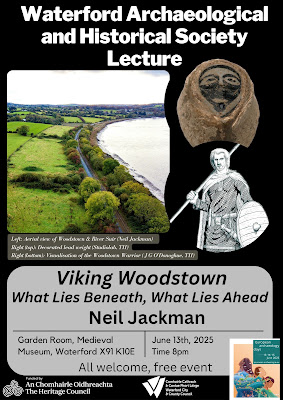The first WAHS summer outing of 2025 is to historic Mothel, near Clonea Power. Mothel is noted for the remains of its medieval Augustian abbey which is located in a historic graveyard containing many fine memorials. Our guide will be John Tierney from Historic Graves. John has worked with the local community in Mothel in recent years to record the graveslabs in the cemetery. As part of the outing John will give a demonstration of techniques that can be used to record historic grave memorials without damaging them.
Friday, June 20, 2025
First Summer Outing of 2025 : MOTHEL with guide John Tierney on June 22nd
Monday, June 9, 2025
Viking Woodstown: what lies beneath, what lies ahead by Neil Jackman 13/06/25
The Waterford Archaeological and Historical Society in partnership with Waterford City & County Council’s Heritage Office is delighted to host a special lecture as part of the European Archaeology Days at 8 pm on Friday, June 13th in the Garden Room of the Medieval Museum, Waterford (Eircode X91 K10E) when Neil Jackman, will deliver a talk titled ‘Viking Woodstown: what lies beneath, what lies ahead’.
In 2003, archaeologists carrying out archaeological assessment in advance of construction of the planned N25 Waterford City Bypass were investigating fields in Woodstown, on the banks of the River Suir, upstream from the city. They uncovered one of the most significant discoveries in the annals of Irish archaeology. A site deemed so significant, that the planned road was moved in order to preserve it.
The initial excavations, followed by a small research dig, identified the site as a Viking longphort, an overwinter camp, with a focus of activity dating to c.AD 850–950, the earliest phase of Viking activity in Ireland. Only 5% of the site was excavated, though it produced nearly 6,000 artefacts, including the grave of a person of high status, who was buried with their weapons. The excavations also revealed evidence for trade, craft and industry. These results were detailed in Woodstown – A Viking Age Settlement in County Waterford published in 2014.
In recent years, Woodstown has undergone a series of detailed geophysical and non-intrusive surveys. The surveys have been developed as a collaboration between leading geophysicists in Ireland and Norway, who have combined a variety of approaches to develop a deeper sense of what lies beneath the surface of these quiet fields beside the Suir.
The combined evidence from these surveys, with the previous excavations, suggest that Woodstown wasn’t just a base for raiding and plundering the surrounding countryside. It was a substantial settlement, and a centre for trade, commerce and industry.
Unlike other Viking settlements in Ireland, such as Dublin, Cork or Waterford itself, Woodstown never developed into a modern city. That lack of development has left the monument largely intact at foundation level, allowing a unique opportunity to examine a Viking settlement that was ‘fossilised’ in time.
To fulfil the potential of the site, and to better ensure its protection, in 2020, a Conservation Management Plan was published that helps to set out the future plans for Viking Woodstown, in terms of how to best understand, protect and promote the site.
Neil’s talk will provide an overview of the results of the surveys, and discuss what the findings might tell us about the nature of the settlement at Woodstown. It will explore some of the key questions that Woodstown asks, such as why it may have started, and why it may have ended, and it will discuss the future plans for this internationally significant Viking monument.
Neil Jackman is a professional archaeologist with more than 25 years experience in Ireland, and has directed the excavations of a wide variety of monuments, ranging from Neolithic passage tombs, to early medieval mills, and more.
Neil specialises in public and community archaeology, and is the director of Abarta Heritage and Tuatha Ireland. Neil is passionate about connecting people to the rich heritage that surrounds us here in Ireland, and he is involved in a number of public engagement projects, such as the Adopt a Monument Scheme with the Heritage Council, as well as hosting the popular Amplify Archaeology Podcast.
Neil authored the Conservation Management Plan for the Woodstown Viking Site, an ambitious and long term vision for how best to protect, promote and present Woodstown, and how to connect it with the people of Waterford to ensure its long term engagement and sustainability.


